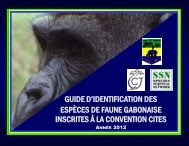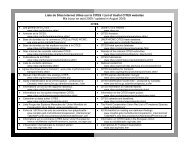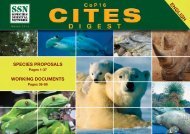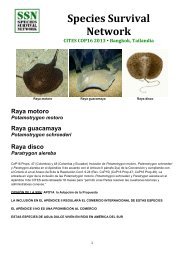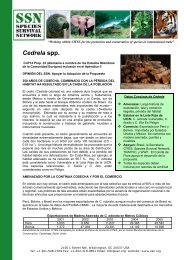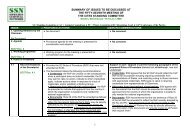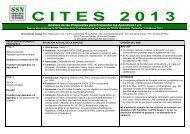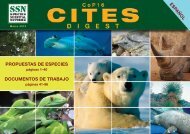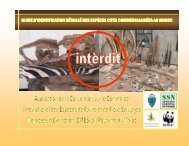SSN's Comments on South Africa's Regulations on Threatened and ...
SSN's Comments on South Africa's Regulations on Threatened and ...
SSN's Comments on South Africa's Regulations on Threatened and ...
Create successful ePaper yourself
Turn your PDF publications into a flip-book with our unique Google optimized e-Paper software.
Part 5. Circumstances in which permit applicati<strong>on</strong>s must be refused<br />
Applicati<strong>on</strong>s for hunting of listed threatened or protected animals if hunting off-take limits are<br />
exhausted<br />
Clause 26 states that an issuing authority must refuse an applicati<strong>on</strong> for a permit to hunt if the annual<br />
off-take limit for hunting that species has been met. We recommend that the text state that the impact<br />
of hunts <strong>on</strong> wild populati<strong>on</strong>s be examined routinely over the course of the year where annual off-take<br />
limits apply. We further recommend that the text state that the annual off-take limit must be<br />
immediately lowered in the event that routine examinati<strong>on</strong> of the hunting impact <strong>on</strong> the wild populati<strong>on</strong><br />
causes any c<strong>on</strong>cern about the biological sustainability of the annual off-take limit.<br />
Applicati<strong>on</strong>s for translocating listed threatened or protected animals to extensive wildlife systems<br />
Clause 27(a) states that an issuing authority must refuse a permit applicati<strong>on</strong> for the transfer, transport<br />
or translocati<strong>on</strong> of a specimen to an extensive wildlife system if “such extensive wildlife system falls<br />
outside the natural distributi<strong>on</strong> of that animal species”. The term “natural distributi<strong>on</strong> range” requires<br />
clarificati<strong>on</strong> about whether this is the current, recent or historical natural distributi<strong>on</strong> range.<br />
Clause 27(b)(ii) states that an issuing authority must refuse a permit applicati<strong>on</strong> for the transfer,<br />
transport or translocati<strong>on</strong> of a specimen to an extensive wildlife system if there is a risk of “genetic<br />
mixing with other species in that extensive wildlife system”. We recommend adding the following,<br />
“with other species or subspecies in that …”<br />
Clause 27(b)(iii) states that an issuing authority must refuse a permit applicati<strong>on</strong> for the transfer,<br />
transport or translocati<strong>on</strong> of a specimen to an extensive wildlife system if there is a risk of “introducing<br />
inferior specimens that may affect the genetic traits of the species of that animal in that extensive<br />
wildlife system”. Individuals that may affect the genetic traits of the populati<strong>on</strong> may not always be<br />
“inferior”; for example, hybrids may show increased survivability compared to ancestral populati<strong>on</strong> or<br />
may be inferior in <strong>on</strong>e trait but not in another. We recommend deleting the term “inferior”.<br />
Applicati<strong>on</strong>sfor captive breeding <strong>and</strong> keeping of listed predators<br />
Clause 28(1)(a) states that an issuing authority must refuse an applicati<strong>on</strong> for a permit for the captive<br />
breeding or keeping of specimens of a listed large predator species except if the purpose of such<br />
breeding is for “the c<strong>on</strong>servati<strong>on</strong> of the species”. Further elaborati<strong>on</strong> is needed <strong>on</strong> the term<br />
“c<strong>on</strong>servati<strong>on</strong> of the species”. Captive breeding <strong>and</strong> keeping of listed predators has very limited<br />
c<strong>on</strong>servati<strong>on</strong> value <strong>and</strong> those situati<strong>on</strong>s must be anticipated <strong>and</strong> specifically listed in this clause. The<br />
IUCN statement <strong>on</strong> captive breeding[5] states, “Captive populati<strong>on</strong>s need to be founded <strong>and</strong> managed<br />
according to sound scientific principles for the primary purpose of securing the survival of species<br />
through stable, self-sustaining captive populati<strong>on</strong>s.” The statement further notes, “Captive programmes<br />
involving species at risk should be c<strong>on</strong>ducted primarily for the benefit of the species <strong>and</strong> without<br />
commercial transacti<strong>on</strong>s. Acquisiti<strong>on</strong> of animals for such programmed should not encourage<br />
commercial ventures or trade. Whenever possible, captive programmed should be carried out in parallel<br />
with field studies <strong>and</strong> c<strong>on</strong>servati<strong>on</strong> efforts aimed at the species in its natural envir<strong>on</strong>ment.” We<br />
recommend amending the sub-clause to read, “… c<strong>on</strong>servati<strong>on</strong> of the species where, founded <strong>and</strong><br />
managed according to sound scientific principles, the primary purpose is for the benefit of the species<br />
by securing the survival through stable, self-sustaining captive populati<strong>on</strong>s <strong>and</strong> without commercial<br />
transacti<strong>on</strong>s.”<br />
10



